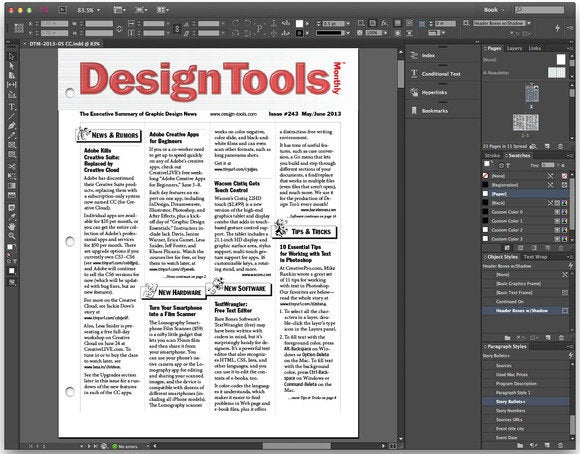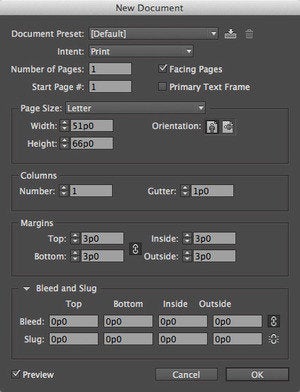When Adobe transformed the way it releases software—from selling its Creative Suite software in a box to releasing Creative Cloud software as a service, it also started featuring regular upgrades to InDesign and the rest of Adobe’s slate of professional creative applications.
InDesign programmers have been rewriting InDesign’s underlying code for several years to best leverage the most current operating systems and hardware. The result is a speedier InDesign CC with support for Apple’s Retina and other similarly high-resolution displays, a new interface, a font-menu overhaul, a new QR Code generator, and significant ePub improvements.Speed and interface updates
The most profound changes to InDesign are under the hood. If you have one of Apple’s new Retina displays, you’ll notice a much sharper-looking interface. Also, because InDesign is now a 64-bit application, it can take advantage of more than 3GB of RAM, which boosts performance when you’re working with very large or complex files. Launching the application takes about the same amount of time as with the previous version, but the familiar welcome screen is gone; instead, you’re taken directly to the main InDesign interface.
InDesign’s new, darker interface brings it into visual alignment with Photoshop and Illustrator, but you can control the color of the app in the preferences.
The New Document dialog box boasts several improvements: Icons near the top let you save or delete presets, the bleed and slug settings are more obvious, and a new preview button tells InDesign to display the new document in the document window before you click the OK button.
One general improvement is more effective navigation of dialog boxes—pressing the Tab key moves you from field to field and from button to button.
Font-menu updates
The font menus in InDesign CC are packed with new features. In previous versions, you could type the first few characters of a font’s name to find it, but now InDesign displays fonts that contain that string of characters anywhere in their name. This makes finding bold, extended, or pro fonts much easier, and it helps with finding fonts that have similar names, such as ITC Garamond and Adobe Garamond.
Previewing how text will appear in various fonts is easier too, as you can now click on a font name to see selected text in that font, or use the up and down arrows on your keyboard to navigate from one font to the other.
Adobe also changed how font family members are displayed. For example, the bold and italic versions of a font are now indented under the main font name instead of in a submenu to the right of the font family name. Clicking the disclosure triangle next to the font family name lets you show or hide family members.
You can now create a personal set of favorite fonts and limit the font list to just those favorites. Simply click the star next to a font name to add it to your favorites, and then show only your favorites by enabling the Show Favorite Fonts Only checkbox in the Font menu in the control panel or the character panel (but, oddly, not in the Font menu under the Type menu).
QR Code generator
Quick Response (QR) Codes have become so commonplace in promotional materials that Adobe decided to include a new QR Code generator under the Object menu in InDesign CC. Just choose a style of QR Code (Web Hyperlink, Plain Text, Text Message, Email, or Business Card), type in the information you want the QR Code to display or link to, and then choose a color. InDesign generates the QR Code and either drops it into the currently selected frame, or loads your cursor so you can place it on your page.
The QR Code, which is a resizable vector image, is embedded in the InDesign document, so you don’t have to keep track of a linked picture file. To edit its content, just right-click the QR Code.
ePub improvements
Adobe also quietly improved many critical features for generating ePub files. ePub is the standard format for eBooks on Apple’s iBookstore, and on the Nook, Kobo, and other e-readers. Now, you can export hyperlinked InDesign indexes, and map object styles to HTML tags and CSS classes. Embedded fonts now work in Apple’s iBooks, and you can assign ePub attributes to objects via the Object Styles dialog box.
As of this writing, Adobe has not yet enabled certain advertised features for Creative Cloud. Missing, for example, are the Sync Settings function, which allows you to save preferences to Creative Cloud and then apply them to InDesign CC on a different computer; the ‘Save to Cloud’ feature, for sharing documents; and the Sync Fonts feature, which lets you use your fonts on other computers. Adobe expects to add these features in the next quarter.
Adobe Exchange and InCopy
InDesign CC now has an Adobe Exchange window (Window > Extensions > Adobe Exchange) that lets you browse, buy, and install plug-ins and other add-ons. When you click an item, more information appears.
Adobe InCopy CC, Adobe’s text editor for InDesign documents, also received updates to its code base and interface, and shares InDesign’s improved font-menu features and support for Retina displays.
Bottom line
InDesign CC contains very few new features—from a user’s perspective this is not a major upgrade. However, if your work involves creating ePub books, you’ll want InDesign CC just for the improvements to ePub formatting. Numerous enhancements to the font menus make choosing fonts much more efficient and flexible. If you frequently generate QR Codes, having that feature inside InDesign is handy, although there are also several free online sources for generating them, such as QR Stuff, Quik QR, and QR Code.
If you’re happy with InDesign CS6 and don’t already subscribe to the Creative Cloud suite, you may not feel the need to upgrade just yet.







